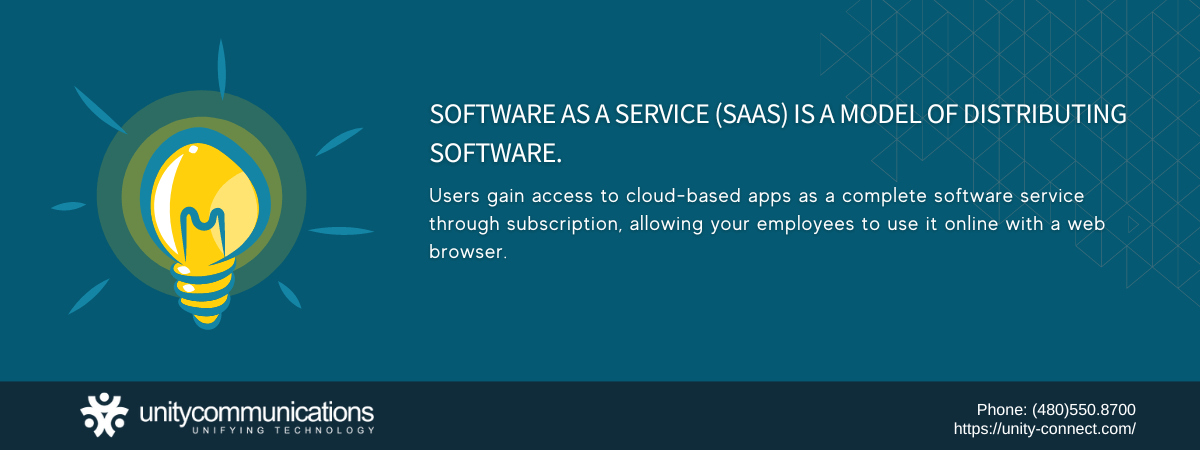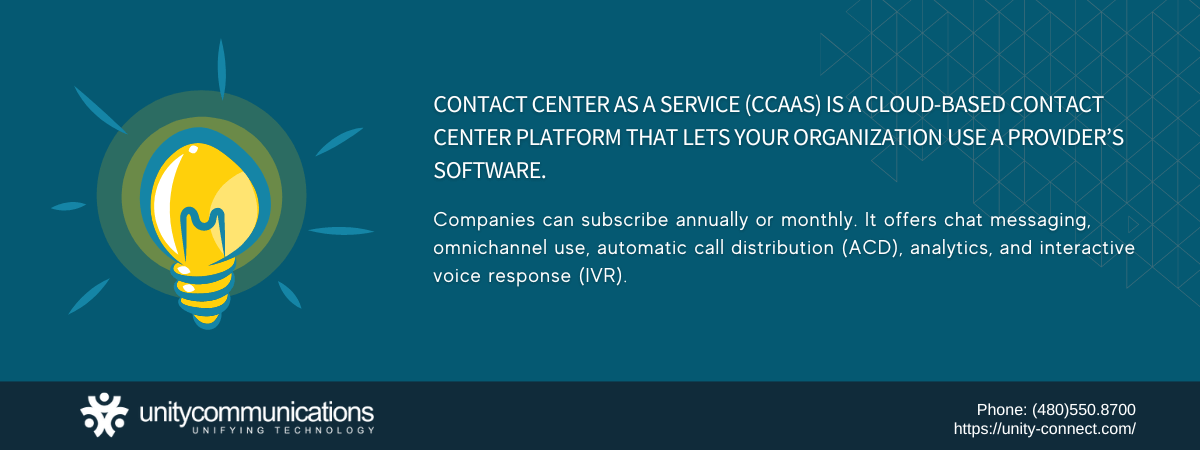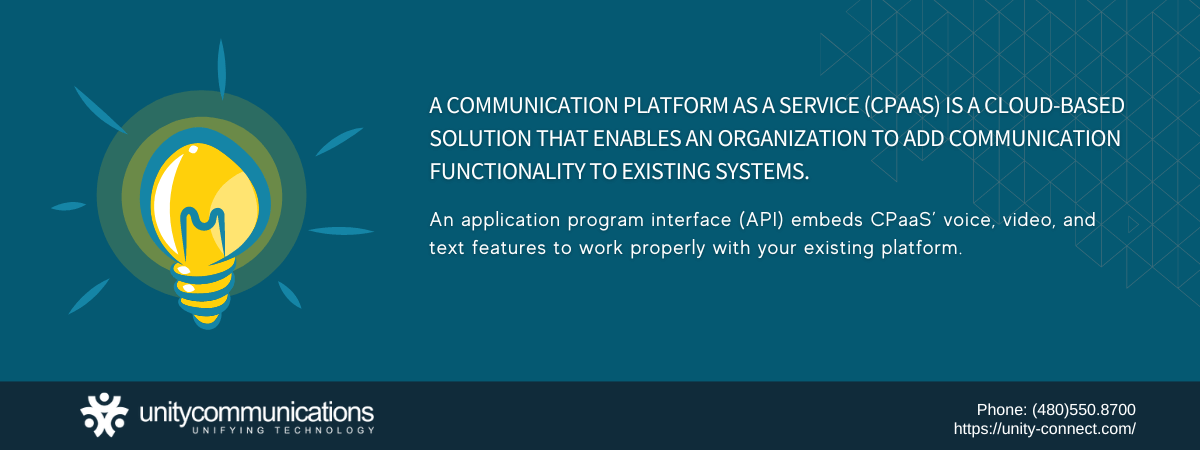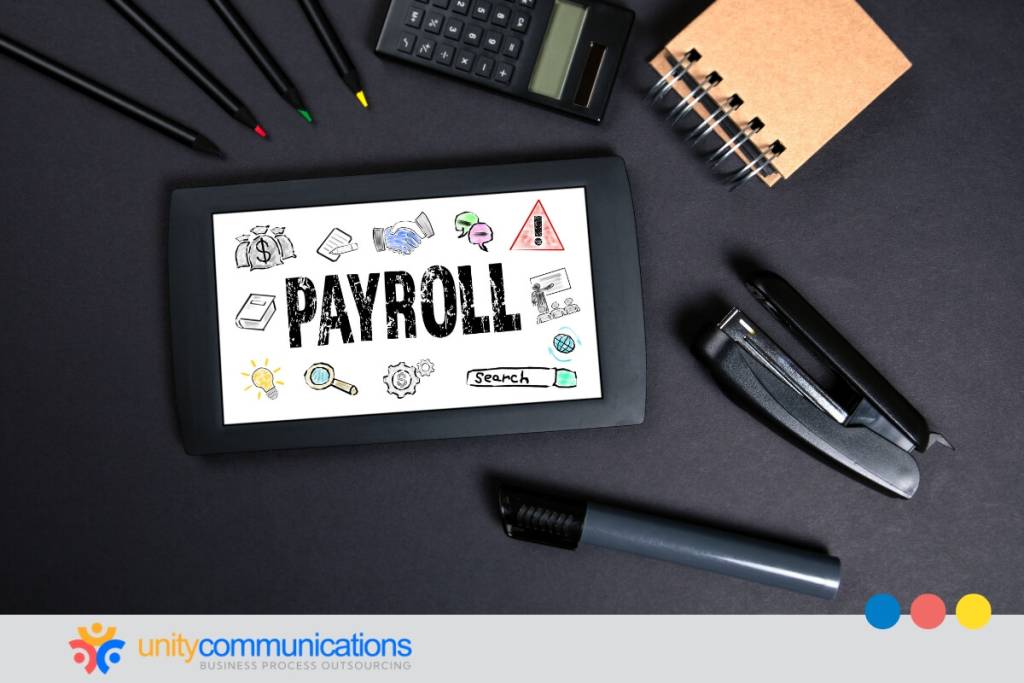Table of Contents
Communication platform as a service (CPaaS), contact center as a service (CCaaS), and software as a service (SaaS)—what’s in their names? Are you new to these terms?
If you want to know their meaning and learn more about them, this blog post is for you.
This article helps you understand the concepts, features, advantages, drawbacks, and more of these services. It also assists you in applying these services to business process outsourcing (BPO) strategies to achieve greater productivity and revenue.
Let’s start exploring. Read until the end to find out which platform is best for you.
What Is SaaS?
Software as a Service (SaaS) is a model of distributing software. Users gain access to cloud-based apps as a full software service that charges based on usage. Your business subscribes to an app or service, allowing your employees to use it online with a web browser.
The cloud provider handles SaaS infrastructure in its data center. It runs the service’s hardware and software for clients to access and store secure data. Examples of SaaS are Amazon Web Services, Cloud-Based Microsoft Office 365, Google Workspace, Slack, MailChimp, Hubspot, DocuSign, Dropbox, ZenDesk, and NetFlix.
Features
Explore some of the characteristics of SaaS below.
- Flexible infrastructure. It scales smoothly up and down, regardless of app usage. The service provider offers the user expandable server capacity based on consumption. You rent the apps you need and pay an amount based on usage.
- Multi-tenant architecture. Multiple cloud users share the same network or computational resources. They share a service provider’s physical server to store data. Users’ digital records are separate and secured.
- Ease of access. SaaS offers data from any web-enabled device, regardless of location; it tracks data consumption and allows authorized access. All authorized users can examine the saved data in real-time.
- Customizable site. Business and individual users can modify a website, software, or a device’s user interface (UI) according to their needs. The app’s design and feel, as well as data fields, are changeable.
Advantages
The following are five benefits of using SaaS:
- Scalability and adaptability. You can use many or a few of the features or services. With no fixed payouts, you pay only for what you use. The service is flexible; you can modify functionality, people, and data volume when your firm expands or slows.
- High-security level. Service providers use the newest technologies and best practices to secure SaaS. All users, including those with sensitive data, benefit from maximum online protection. Data backups help the platform recover quickly from web incursions.
- Instant and regular updates. Automatic upgrades and patch management improve SaaS service and functionality. They save users from having to pay or download new code. External patches reduce the in-house team’s burden.
- Available advanced systems. Sophisticated applications, including hardware, software, middleware, customer relationship management (CRM), and enterprise resource planning (ERP), are at your fingertips. The service provider manages everything, from deployment to updates.
- Accessible mobile and remote workers. Anyone with an internet connection and a web browser can access apps and data. They can access information without going to the workplace, so online work is common. The provider also streamlines processes.
Drawbacks
On the other hand, some of the potential disadvantages of SaaS include:
- Users’ insufficient control. All users rely on the third-party vendor to manage SaaS. When the service provider updates the software, deployment is for everyone. Businesses must adopt the new one and retrain their personnel.
- Issues in data migration. Changing service providers is difficult. Incompatible technology might make moving large amounts of data from the previous vendor difficult. Cloud computing has a customer lock-in concern because consumers rely on proprietary apps.
- Performance difficulties. On-premises servers, however big and expensive, run browser-based apps best. They are fast and rarely have latency or network issues. Because SaaS employs remote data centers, its web performance might not be as good as that of physical computers.
- Contract complexities. SaaS terms and conditions are complicated. Not understanding the contract can lead to heavy fines, especially when software license overuse takes place. This can happen when app use goes beyond the license terms. Noncompliance is expensive for businesses.
- Application integration concerns. Assigning a service provider to host various apps can be a problem. Your company’s proprietary software might not integrate with the SaaS vendor’s system. Incompatibility causes poor performance of network, database, OS, mobile devices, browsers, and other applications.
What Is CCaaS?
Contact center as a service (CCaaS) is a cloud-based contact center platform that lets your organization use a provider’s software. Companies can subscribe annually or monthly. The provider hosts and manages CCaaS in an off-site data hub. It offers chat messaging, omnichannel use, automatic call distribution (ACD), analytics, and interactive voice response (IVR).
The contact center platform enhances customer experience to maximize revenue. It streamlines communication technologies to help employees and customers interact effectively. Examples of CCaaS are Salesforce, Cisco Broadsoft, Genesys, Talkdesk, Twilio, Avaya OneCloud CCaaS, and Aircall.
Features
Let’s look at CCaaS’ five attributes:
- Software analytics and customer experience monitoring. CCaaS tracks data gathered from contact center activities. CCaaS evaluates the data for insights; it reveals client preferences, complaints, and more.
- Artificial intelligence (AI). The platform helps contact center agents with daily tasks and customer interaction. It also serves as a virtual assistant, as good in conversation as a human agent. AI is being employed more and more frequently by BPO companies.
- CRM integration. CCaaS links a CRM application with other systems to streamline customer data processing. It tracks and manages customer communication with any third-party technology.
- Call recording and management processes. The software helps review agent performance and productivity. It allows BPO firms to record incoming and outgoing calls for training, analysis, and marketing. Businesses thus comply with legislation governing call recording.
- Call routing and IVR. Call routing sends voice calls to a queue based on a benchmark. IVR allows customers to talk to a computer system. It then gets the information and directs calls to the qualified contact center agent.
Advantages
Check out some CCaaS benefits:
- Higher quality of service. AI-powered virtual assistants help customer support agents solve issues, requests, and queries faster. They handle basic and time-consuming activities, freeing agents to focus on customer service. Automation increases efficiency.
- More accurate customer insights. Contact center platform analytical tools generate more detailed information and analysis on consumer behavior, preferences, and dislikes. The tools help you design tactics based on in-depth insights into their future behavior.
- Access to self-service options. CCaaS applications enable online buyers to communicate with a chatbot. This program replicates human conversations (written or spoken) to help users place or cancel orders, edit or see account records, and resolve simple product or service issues by themselves.
- Reduced costs. CCaaS has minimal power usage, reduced technical support staffing, and no upfront costs. It focuses on higher-value projects, consolidating bills with multiple due dates into monthly payments.
- Better customer agent performance. CCaaS combines vital customer data from different communication channels onto one screen. Contact center specialists readily access them—no more browsing, checking, or switching to various sources for data.
Drawbacks
Here are five likely issues of CCaaS:
- Existing work activities might be altered. Moving from current call center systems to contact center platforms requires significant workflow changes. Team leaders must change processes, and members must adapt to new task methods. Change resistance hinders or slows down user acceptance.
- Overpaying for some functions is possible. Some CCaaS providers bundle certain unnecessary functions or features. Adding social media channels to their omnichannel service is questionable if contact volume hasn’t increased.
- Spending additional resources on staff training is inevitable. Customer service, sales, marketing, and other departments need retraining. You may spend more time, money, and effort on CCaaS employee training.
- Systems may be incompatible. Your current software or in-house technology might not sync with the contact center platform. Integration issues influence workflow, efficiency, and production. Your proprietary applications might not connect or communicate properly with the CCaaS tools.
- Data safety can be a concern. CCaaS carries massive amounts of critical customer data. As such, cloud service providers face data breach challenges. Even with secure technologies, cyber breaches are possible. With internet use growing, cybersecurity is also a growing concern.
What Is CPaaS?
Communication platform as a service (CPaaS) is among the contact center platforms available in the cloud computing market. This internet-hosted software adds communication functionality to existing systems. It lets organizations choose features for software and apps.
The services include IVR, videoconferencing, chat, short message service (SMS), and multimedia messaging service (MMS). An application program interface (API) embeds CPaaS’ voice, video, and text features to work properly with your existing platform.
CPaaS providers typically charge you a monthly standard rate for minutes used (voice and video) or the bulk of messages sent (for text). Twilio, Vonage Holdings, Microsoft, Bandwidth, Amazon Connect, and MessageBird are some examples of CPaaS.
Features
The features of CPaaS include:
- SMS and MMS. The service transmits and receives text messages, photos, videos, and other media formats. It automates SMS/MMS processing, sending alerts and group text messages from any number and checking when messages are opened.
- Social media messaging. CPaaS lets businesses send and receive WhatsApp messages. The free messaging app works seamlessly with the contact center platform. Social network communication enhances customer engagement.
- API voice calls. The service’s voice API streamlines applications by adding outgoing calls. CPaaS expands or contracts call capacity based on your needs. Users can add phone numbers and call features so that callers can reach specific teams.
- Calls using WebRTC. Web real-time communication (WebRTC) is a free and open API-based solution for web browsers and mobile apps. CPaaS includes WebRTC-based calling. It lets you add audio and video capabilities, including call queuing, recording, and conferencing.
- Call routing. Webhooks guide CPaaS inbound calls to a specific receiver. Once engaged, the system performs a set of orders to make the call. This feature is best for high call volumes because incoming calls can be automated and modified.
Advantages
Let’s also consider five benefits of CPaaS:
- Effortless integration. CPaaS uses APIs to integrate quickly with systems and apps. Your tech support team can integrate the services without altering your platform. Enterprise-grade app deployment and end-user connectivity are straightforward.
- Personalize requirements. The contact center platform lets you customize functions. For example, you might choose voice and text chat, but not videoconferencing. Tech support can adopt features to match your business needs.
- Higher revenue potential. Many firms use fixed and mobile phones to communicate with customers. CPaaS suppliers offer live chat and video calling for faster assistance. Better customer service boosts sales.
- Better agent-customer engagement. CPaaS enables real-time caller-agent interactions. Multi-tenancy options let various users utilize the same feature in a secure and segregated setting, which increases user satisfaction and customer retention.
- Lower costs. CPaaS reduces infrastructure and human resources costs. Many providers impose “pay-as-you-go” fees based on consumption. This payment plan allows for unlimited service use.
Drawbacks
Still, some of the potential disadvantages of CPaaS are:
- Software lags. Multiple APIs might slow connectivity, downloading, and uploading. Too many can cause software delays and malfunctions. Slow platform performance hinders productivity, which can frustrate users or consumers, hurting businesses.
- Coding background requirement. Regular users cannot maximize CPaaS. API development requires skilled technical specialists. Software engineers and developers employ API management tools that require coding knowledge.
- App development is essential for smooth operation. Your in-house development team must spend time and skill designing an app, website, or device’s user interface (UI). The API lacks the UI for an efficient, accessible, responsive app or site.
- Data exposure to online intruders. APIs might expose data to cyberattacks. Unauthorized API access can cause financial and data loss. Hackers or DDoS attacks can knock down the CPaaS system.
- High-speed internet dependency. All contact center platforms need a stable and fast internet connection to use tools and apps. You need a wireless internet connection to transact with consumers, clients, and suppliers. Internet interruptions slow down the workflow.
Which Contact Center Platform Must I Use?
At this point, you might be wondering which platform is best for you. The right answer depends on your needs, budget, market, and business size.
There is no one-size-fits-all solution. Each cloud-based service caters to different requirements, tasks, and processes, to name a few. Below are some tips to help you decide on the proper service.
When To Use SaaS
SaaS is an ideal solution in scenarios where:
- There’s a lack of resources (time, money, or expertise) to develop in-house applications.
- The need to purchase and manage physical servers for software access is undesirable.
- You’re operating a small to medium-sized business with limited staff and budget constraints.
The SaaS provider manages the software, servers, coding, and databases in this model. Services are accessed online, with payments made periodically or based on usage.
Examples include:
- Google Docs, which eliminates the need to develop an online word processor, offering immediate collaboration on content, reports, and documents.
- Shopify, providing a platform to quickly create and manage an online store, with subscription-based access to e-commerce development tools.
When To Use CCaaS
CCaaS, a specialized form of SaaS for contact centers, offers customer service and related applications that are easy to integrate and use within your network. This platform is particularly beneficial for new contact center ventures.
However, a limitation is that these applications offer limited scalability and customization, restricting the ability of tech teams to modify them as needed.
Benefits for the customer service team include:
- Essential tools for delivering superior customer experiences.
- A range of communication channels like phone, email, chat, and social media to connect with customers on their preferred platforms.
- Ready-to-use solutions enable quick setup and operational efficiency for the team.
When To Use CPaaS
CPaaS differs from CCaaS as it is not a SaaS product but focuses on APIs and SDKs for creating bespoke software development applications tailored to specific business needs
CPaaS is suitable when you want to personalize applications without building a communication platform from the ground up. However, your development team must create interfaces for customer service and interactions, as APIs alone don’t offer this.
Opt for CPaaS if:
- You plan to scale your contact center extensively.
- You would prefer to be free from restrictions imposed by a service provider’s software.
- You aim to craft a unique customer experience.
CPaaS APIs allow for your contact center’s functionalities to be enhanced, expanded, or customized.
The Bottom Line
Picking a contact center platform to help you with business processes is a major decision. Knowing the benefits and drawbacks of each service before making a choice is critical.
Ensure that you examine everything—the details of the platform, the services you need, and the scalability of the services. Contact different service providers and ask about the solutions they offer. Tell them about your business needs and ask how their platforms help you.
Unity Communications is one of the BPO companies happy to discuss different contact center platforms with you. Reach out to Unity Communications to learn more about cloud computing services.









